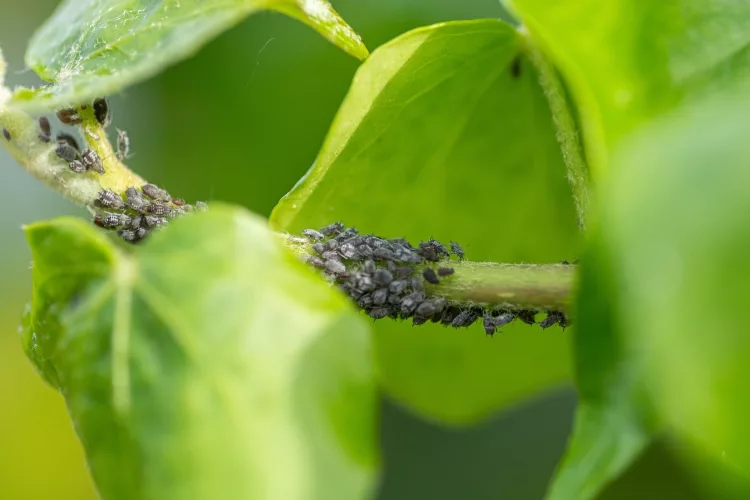reviewed by Truman Perkins
Termites, are small ant like winged insects, often referred to, as "white ants", due to their white creamy color. They are found living in huge colonies. They have been ranked as the most destructive pests around the globe as they cause huge damage to plants, wood and property.
They have a big appetite, they eat 24 hours a day, every day. Termites primarily feed onplant and wood matter specifically dead plant matter or wood. Termites are the most damaging pests for agriculture, forestry and housing.
Getting rid of termites is not easy as one may not even be aware of the termite infestation until it's too late. Their diet comprises of cellulose and termites are capable of tearing through any material that contains cellulose.
Both, natural and chemical methods are used for getting rid of termites from plants.
Contents

Most efficient way of getting rid of termites from plants is by preventing termite infestation instead of repeated soil treatment. In the beginning of the rainfall season, new infestation starts. During this time using chlorpyriphos is one practical recommendation for plants, crop, and gardens etc. Chlorpyriphos is a long lasting insecticide.
Generally, termites mainly feed on dead wood and are harmless to plants or non-woody plants. However, termites may infest and feed on roots of potted plants due to the presence of moisture under dry conditions. Termite infestation in potted plants may lead to the deterioration of the plant.
Under such circumstances, termites can be eliminated without harming the plant by immersing the pot in a solution of 2 tablespoons of insecticidal soap per 1 quart of water for about 20 minutes. However, this is applicable to smaller pots only, whereas, soil treatment is required for larger potted plants.
For the plants that are not utilized as food, soil is treated with imidacloprid, a systematic insecticide.Replacing the wooden pot with plastic, cement or terra cotta pots also helps prevent the infestation.
Various types of bait stations can be found in stores and ordered online that perform different functions. Bait stations are placed in or above the ground. These bait stations consist of cellulose containing baits that are contaminated with poisonous substances.
Termites tend to feed and carry the bait back to the colony which helps eliminate entire colonies. Poisoned baits are affordable pesticides that tend to work fast. They are effective in getting rid of termite colonies. Poisoned baits can be placed in the garden near their colonies to protect outdoor plants or inside homes to protect indoor plants.
Chemicals are hazardous for the environment and thus, natural remedies prove to be efficient and eco-friendly. Some of the natural remedies that are utilized for getting rid of termites are listed below:
Nematodes are parasitic worms and serve as the best natural remedy for eliminating entire termite colonies. Parasitic nematodes have an appetite for termites. Nematodes are available in various stores and they can be ordered online as well. Place these tiny worms where there is termite infestation. Nematodes reproduce and feed on termites till the entire colonies are eliminated.
Old and useless boxes or cardboards can be found in about every house. Natural and effective termite traps can be created by spraying water over the cardboard in order to make it wet and placing it near a termite colony. Termites will then attack the wet cardboard as it contains both, moisture and cellulose. It can then be removed and burned.
Decaying leaves, bark or compost is turned and used as mulch for insulating and enriching the soil. However, this mulchmay become the perfect breeding grounds for termite infestation as it retains moisture when wet and it contains cellulose. The moisture in the gardentends to attract termites. In some cases, removing mulch from home can prevent and eliminate termite infestation.
Last but not the least, physical methods are also used for getting rid of termites from plants and gardens.
It is highly likely that the moisture in the garden may attract termites as theyrequire moisture to keep their eggs, colonies and bodies moist. To remove termites from your garden, use a gardening hoe for moving the soil around till termites are visible. Once visible, place the soil containing termites in a plastic trash bag and dispose it off. This step requires using a shovel. Once removed, soil should be regularly checked to look out for termite infestation occurring again.
5 Essential Plants Mentioned in Vedas
 |
 |
 |
 |

About Truman Perkins
Truman Perkins is a Detroit-based SEO consultant who's been in the business for over a decade. He got his start helping friends and clients get their websites off the ground, and he continues to do so today. In his free time, Truman enjoys learning and writing about gardening - something he believes is a natural stress reliever. He lives with his wife, Jenny, and their twins in Detroit.
 |
 |
 |
 |
Check These Out
Get new FREE Gifts. Or latest free growing e-books from our latest works.
Disable Ad block to reveal all the links. Once done, hit a button below
 |
 |
 |
 |